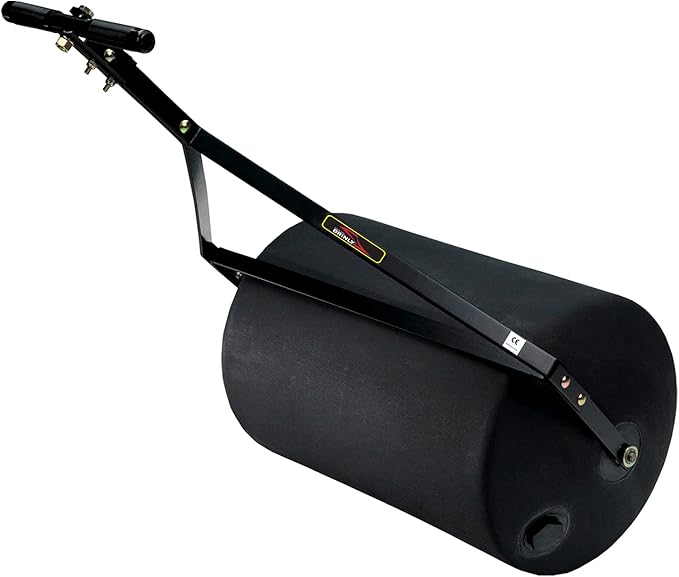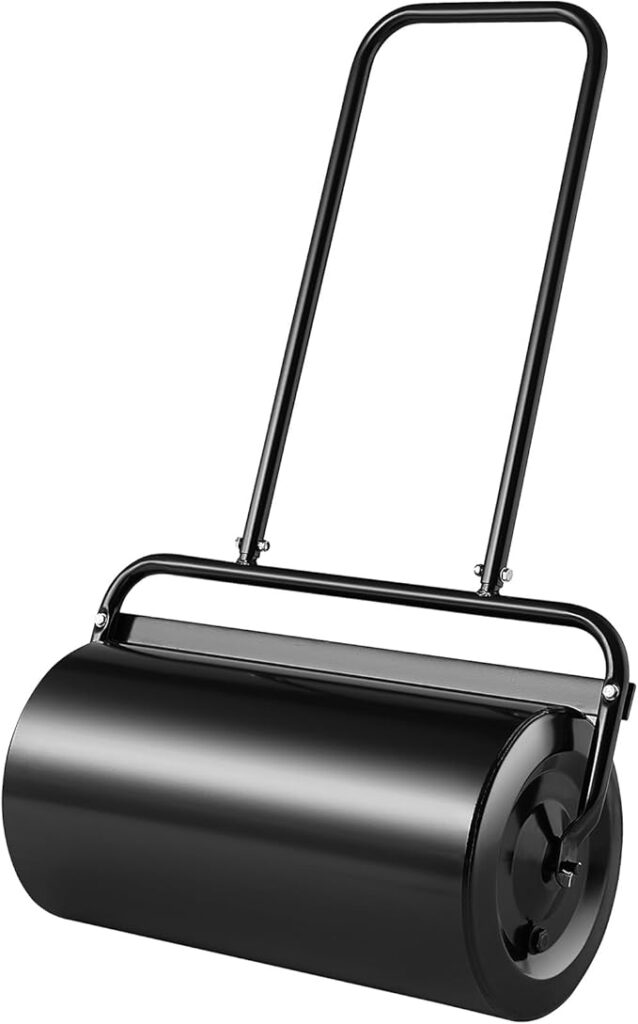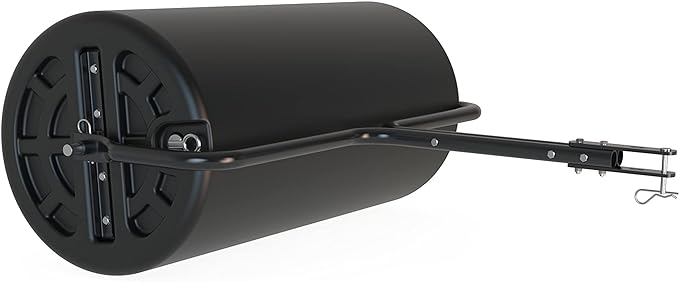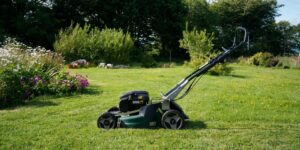Advertiser Disclosure
We independently review everything we recommend. When you buy through our links, we may earn a commission.
The Best Lawn Roller
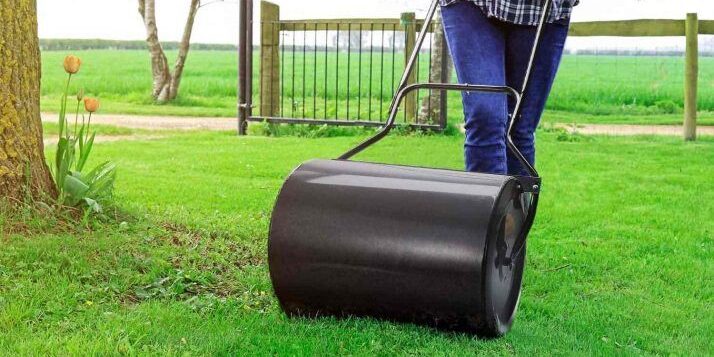
Creating a picture-perfect lawn doesn’t happen overnight, but having the right tools makes all the difference. Whether you’re dealing with bumpy terrain, establishing new grass, or preparing for sod installation, a quality lawn roller becomes your best friend in achieving that smooth, professional-looking landscape.
Let’s dive deep into everything you need to know about lawn rollers – from understanding when and why to use them, to choosing the perfect model for your specific needs.
Everything We Recommend
🏆
The Best Heavy-Duty
Easy-turn plug stays attached for quick 28-gallon fill and drain
Push or tow design covers tight spots and open lawns with ease
28-gallon drum holds 270 lbs water or sand for maximum impact
24-inch rustproof poly drum built for lasting outdoor durability
Extra-large fill hole fits garden hose for fast water loading
Lightweight empty drum stores easily in garage or shed
Rounded edges and scraper bar protect lawn and keep roller clean
Universal hitch pin connects to most tractors, ATVs, and ZTRs
Quick assembly with pictorial guide and YouTube video support
Made in USA by Brinly with over 180 years of trusted quality
💎
The Best Large Capacity
13-gallon drum holds 46L for better seed contact and germination
U-shaped handle makes rolling effortless and easy to store
Heavy-duty steel frame ensures balance, safety, and long life
Ergonomic handle, sealed plug, and scraper bar for smooth use
Push-pull roller works on lawns, farms, and large open areas
The Best Compact
18-inch diameter and 36-inch width cover wide lawn areas
Fills up to 400 lbs with water for flattening soil and grass
Under 50 lbs empty for easy transport and quick hose filling
Includes 3-year limited warranty against manufacturing defects
Proudly made in the USA for quality and reliability
What Is a Lawn Roller and Why Do You Need One?
A lawn roller is essentially a large, hollow cylinder designed to smooth and level your lawn’s surface. Think of it as a miniature steamroller for your grass – it applies even pressure across the ground to eliminate bumps, ridges, and uneven spots that make your lawn look unprofessional.
But here’s what many homeowners don’t realize: using a lawn roller after spreading grass seed helps press the seed into the soil reducing the chance of it being blown or washed away. Rolling also helps expedite the germination process. This makes it an invaluable tool for anyone serious about lawn care.
The Science Behind Lawn Rolling
When you roll your lawn, you’re essentially creating better seed-to-soil contact, which is crucial for germination. Lawn rolling flattens the top 1 to 2 inches of soil surface making it more even and level, giving your grass seeds the stable foundation they need to establish strong root systems.
However, timing is everything. Generally, you would not need anything heavier unless you have an ornamental or croquet lawn, which means most homeowners can achieve excellent results with moderate-weight rollers.
Top Lawn Rollers Our Picks
Technical Specifications:
- Drum Width: 24 inches
- Maximum Weight: 270 pounds when filled
- Construction: Heavy-duty steel frame with polyurethane drum
- Capacity: 28 gallons
- Towing System: Universal hitch pin included
Why This Roller Stands Out:
Picture this: You’ve just finished spreading grass seed across your backyard, and you’re worried about the upcoming weekend’s forecasted thunderstorms washing away your investment. The Brinly PRC-241BH-A becomes your insurance policy against seed loss.
What sets this roller apart is its intelligent weight distribution system. At 270 pounds fully loaded, it provides serious compaction power without the aggressive soil compression that damages root development. With this machine, I’ve watched homeowners transform bumpy, uneven lawns into smooth, professional-looking surfaces in just one afternoon.
Real-World Performance Insights:
The steel frame construction means this roller laughs at the punishment that destroys cheaper alternatives. One user told me how their previous plastic roller cracked after two seasons, but their Brinly has handled five years of spring seeding and fall overseeding without a single structural issue.
The polyurethane drum strikes the perfect balance–heavy enough for effective soil contact, yet forgiving enough that you won’t accidentally compact clay soils into concrete-hard surfaces. The 28-gallon capacity gives you precise weight control, letting you start light and add water as needed.
Ideal User Profile: Perfect for homeowners with 1/4 to 1 acre properties who want professional results without professional prices. If you’re establishing new lawns, overseeding annually, or dealing with persistent mole damage, this roller delivers the consistent performance you need.
Technical Specifications:
- Drum Width: 27inches
- Maximum Weight: 140 pounds when filled
- Construction: Powder-coated steel frame with poly drum
- Capacity: 13 gallons (sand or water)
- Operation: Push/pull handle with ergonomic grip
The Smart Choice for Most Homeowners:
Here’s what makes the VEVOR special – it’s the Goldilocks of lawn rollers. Not too heavy, not too light, but just right for the majority of lawn care situations. The 13-gallon capacity means you can achieve effective rolling without the back-breaking weight that makes lawn care a chore.
Dual-Fill Flexibility:
The game-changing feature? You can fill it with sand or water. Water is convenient for most jobs, but sand provides more weight in a smaller volume, perfect for spot treatments or when you need maximum compaction in tight spaces. One landscaper I know uses sand for spring preparation and switches to water for delicate seed-rolling operations.
User Experience Excellence:
The ergonomic handle design reduces fatigue during extended use. After rolling a 3,000 square foot lawn, you’ll appreciate how the balanced weight distribution prevents the arm strain that plagues users of poorly designed alternatives.
Performance Analysis:
The 20-inch width hits the sweet spot for maneuverability around landscape features while maintaining efficiency. You can navigate between trees, around flower beds, and along property lines without the frustration of constantly backing up and repositioning.
Best Fit Scenarios: Ideal for suburban homeowners with established lawns who need occasional rolling for maintenance, seed establishment, or seasonal smoothing. If you’re dealing with typical residential lawn care challenges – spring frost heaves, summer dry patches, or fall overseeding – this roller handles it all with remarkable versatility.
Technical Specifications:
- Drum Dimensions: 18″ diameter x 36″ width
- Maximum Weight: 415 pounds when filled
- Construction: Heavy-duty welded steel
- Capacity: 34 gallons
- Towing System: Universal pin-style hitch
Built for Serious Lawn Enthusiasts:
When you need to cover ground quickly without sacrificing quality, the Agri-Fab 45-0606 becomes your secret weapon. The 36-inch width means you’re covering twice the area of smaller rollers with each pass, transforming large lawn projects from day-long ordeals into efficient morning tasks.
Engineering Excellence:
The 18-inch diameter creates the perfect balance of soil contact pressure and ground coverage. Unlike smaller diameter rollers that can create washboard effects, or oversized ones that bridge over small depressions, this dimension ensures consistent soil contact across varying terrain.
Heavy-Duty Performance:
At 415 pounds fully loaded, this roller doesn’t mess around. It’s specifically engineered for property owners who refuse to compromise on results. The welded steel construction means you’re buying a tool that will outlast multiple riding mowers, becoming a permanent part of your lawn care arsenal.
Practical Applications:
Imagine preparing a half-acre lot for sod installation. With a walk-behind roller, you’re looking at hours of tedious work. The Agri-Fab completes the same job in 30 minutes, freeing you to focus on other aspects of your landscaping project.
Professional-Grade Features:
The universal hitch system connects to virtually any riding mower, tractor, or ATV. The pin-style connection means no fumbling with complicated attachment systems – just line up, insert the pin, and you’re ready to roll.
Target User Analysis: Perfect for property owners with substantial lawns (1+ acres), rural homeowners, or anyone who takes their lawn seriously enough to invest in time-saving, professional-grade equipment. If you’re managing multiple seasonal projects or dealing with challenging terrain, this roller transforms overwhelming tasks into manageable ones.
When to Use a Lawn Roller
Perfect Timing for Lawn Rolling
Spring Preparation: Early spring offers the ideal window for lawn rolling when the soil is moist but not waterlogged. This is when you can effectively smooth winter damage without compacting wet soil.
After Seeding: Rolling immediately after spreading grass seed ensures proper seed-to-soil contact and prevents seeds from washing away during the first rain.
Sod Installation: Before laying sod, rolling creates the level surface necessary for proper installation. After installation, a light roll eliminates air pockets and promotes root establishment.
Damage Repair: Lawn rollers can help repair the damage after moles or ants have invaded your yard, smoothing out the tunnels and mounds these pests leave behind.
When to Avoid Rolling
Despite its benefits, lawn rolling isn’t always appropriate. Rolling the lawn destroys the aggregation and compacts the soil. Compacted soil contains less air and less water, making it much more difficult for roots to grow.
Avoid rolling when:
- Soil is too wet or muddy
- Your lawn is already well-established and healthy
- You’re dealing with clay-heavy soil that compacts easily
- The ground is frozen or drought-stressed
Types of Lawn Rollers: Finding Your Perfect Match
Push/Pull Lawn Rollers
These manual models are perfect for smaller properties and offer excellent control over pressure and direction. Most feature ergonomic handles and weigh between 50-100 pounds when empty.
Best For: Properties under 1/2 acre, precise work around landscaping features, homeowners who prefer manual control.
Tow-Behind Lawn Rollers
Designed to attach to riding mowers, tractors, or ATVs, these models handle larger areas efficiently. They typically range from 24-48 inches wide and can weigh 400-1,000 pounds when filled.
Best For: Properties over 1/2 acre, commercial applications, and anyone with existing riding equipment.
Combination Models
Some modern rollers offer both push/pull handles and towing capabilities, providing maximum versatility. These typically cost more but deliver excellent value for homeowners with varying needs.
Key Features That Make a Difference
Drum Material: Polyurethane vs. Steel
Polyurethane Drums:
- Rust-resistant and lightweight
- Cost-effective for most homeowners
- May warp in extreme heat if not stored properly
- Easier to maneuver when empty
Steel Drums:
- Extremely durable and long-lasting
- Heavier, providing more compaction power
- Susceptible to rust without proper maintenance
- Professional-grade performance
Essential Features to Consider
Scraper Bars: These genius additions automatically clean debris from the drum as you roll, preventing clogs and ensuring consistent performance. The round edges on the rollers prevent lawn damage during tractor turns and are easy on turf.
Baffle Bars: Internal support structures that prevent drum flexing, especially important in polyurethane models. The extra-thick poly drum prevents rusting and warping.
Quick-Connect Hitches: For tow-behind models, these save time and frustration when connecting to your riding equipment.
Drain Plugs: Essential for easy filling and emptying – look for models with accessible, leak-proof plugs.
Size Matters: Choosing the Right Dimensions
Width Considerations
24-Inch Rollers: Perfect for small to medium lawns, these offer excellent maneuverability around obstacles and typically hold 28 gallons (about 250 pounds of water).
36-Inch Rollers: The sweet spot for most homeowners, balancing efficiency with control. These handle mid-sized properties effectively.
48-Inch and Larger: Reserved for large properties and commercial use. These require towing equipment and can weigh over 1,000 pounds when filled.
Weight Capacity Guidelines
Start with your roller 25% filled and test the results. You can always add more water, but removing it requires complete drainage. The goal is effectiveness without soil compaction.
Professional Application Techniques
Proper Filling Strategy
Never fill your roller completely on the first use. Start with about 1/4 capacity and test on a small area. Gradually increase weight until you achieve the desired smoothing effect without over-compacting.
Rolling Patterns for Best Results
Cross-Hatching: Roll in one direction, then perpendicular to your first pass. This ensures even coverage and prevents streaking.
Overlapping Passes: Overlap each pass by 2-3 inches to avoid missed spots.
Speed Control: Move slowly and steadily – rushing leads to uneven results.
Soil Conditions Matter
The ideal soil moisture for rolling feels like a wrung-out sponge – moist but not muddy. Too wet, and you’ll create harmful compaction. Too dry, and the roller won’t be effective.
Maintenance and Storage Tips
Seasonal Care
After Each Use:
- Empty the drum completely
- Clean off debris and grass clippings
- Check for damage or wear
End of Season:
- Thoroughly clean and dry all components
- Apply protective coating to metal parts
- Store in a dry location away from direct sunlight
Extending Roller Life
For polyurethane models, avoid storage in areas with temperature extremes. For steel models, regular cleaning and rust prevention are crucial.
Safety Considerations
Lawn rollers are heavy equipment that demands respect. Always:
- Check the rolling path for obstacles before starting
- Wear appropriate footwear with good traction
- Never exceed recommended weight capacities
- Use proper lifting techniques when handling components
Cost Analysis: Budget vs. Premium Options
Budget-Friendly Options ($100-200)
Consumer-grade polyurethane rollers offer excellent value for occasional use. These handle typical homeowner needs effectively and provide years of reliable service.
Premium Investments ($400-500+)
Professional-grade steel rollers justify their higher cost through superior durability, larger capacity, and enhanced features. Consider these if you have extensive property or plan frequent use.
Common Mistakes to Avoid
Over-Rolling: More isn’t always better. Excessive rolling can damage grass and compact soil harmfully.
Wrong Timing: Rolling wet soil creates long-term problems. Wait for proper moisture conditions.
Neglecting Maintenance: A well-maintained roller lasts decades, while neglected equipment fails prematurely.
Alternative Solutions
Sometimes a lawn roller isn’t the right tool for the job. Consider these alternatives:
Lawn Leveling Rake: Better for minor surface irregularities. Top Dressing: Effective for gradual leveling over time. Core Aeration: Addresses compaction issues that rolling might worsen
Comparative Analysis: Choosing Your Perfect Match
For New Lawn Establishment: The Brinly PRC-241BH-A provides the ideal balance of weight and control for seed-to-soil contact without over-compaction.
For Maintenance Rolling: The VEVOR‘s versatility and manageable weight make routine lawn care tasks effortless and efficient.
For Large-Scale Projects: The Agri-Fab 45-0606 delivers professional results with time-saving efficiency that justifies the investment.
The Bottom Line
A quality lawn roller transforms bumpy, uneven grass into the smooth, professional-looking lawn you’ve always wanted. Whether you’re establishing new grass, installing sod, or maintaining an existing lawn, the right roller makes the job easier and delivers superior results.
Remember, successful lawn rolling isn’t just about the equipment – it’s about understanding when, how, and why to use it. Armed with this knowledge, you’re ready to make an informed decision that will serve your lawn care needs for years to come.
